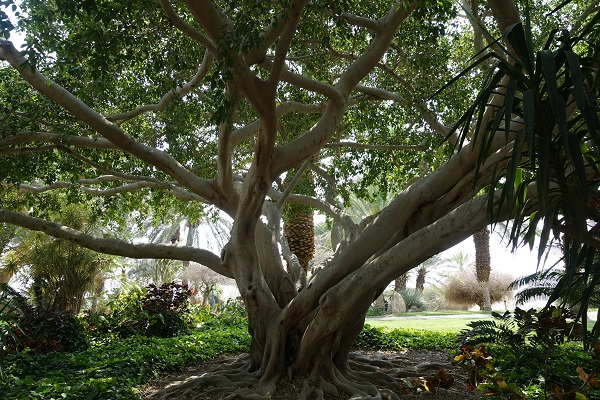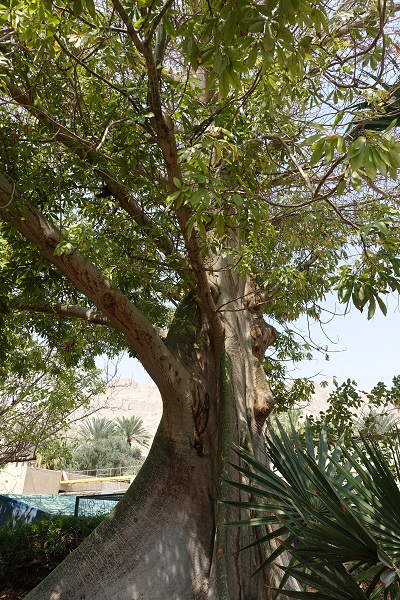White Silk Cotton Tree, Kapok Tree,
Hebrew: צייבה מחומשת, Arabic: قابوق خماسي الأسدية
| Scientific name: | Ceiba pentandra (L.) Gaertn. | |
| Synonym name: | Eriodendron anfractuosum DC. | |
| Common name: | White Silk Cotton Tree, Kapok Tree | |
| Hebrew name: | צייבה מחומשת | |
| Arabic name: | قابوق خماسي الأسدية | |
| Family: | Malvaceae, Mallow Family, משפחה חלמיתיים |

|
| Life form: | Deciduous tree up to 40m. | |
| Spinescence: | bearing short, sharp prickles all along the trunk and branches | |
| Stems: | Light grey columnar trunk that is covered with sharp conical thorns. | |
| Leaves: | Spirally arranged, palmately compound and the 5-8 leaflets are crowded at the end of a 7.5-20cm long petiole. Each leaflet is 8-18cm long, lanceolate, with an entire or slightly serrate margin. | |
| Inflorescence: | Flowers in lateral clusters near the ends of the twigs. | |
| Flowers: | bisexual, 4cm wide, creamy white and have a milky fragrance. There are 5 sepals which are fused to form a tubular calyx, which is deciduous. The 5 petals are also partially fused at the base, to form a trumpet-shaped corolla. Flowers usually open after dusk and last one night, falling off by the following noon. They are pollinated by bats. | |
| Fruits / pods: | Large, smooth, leathery, oblong capsules up to 15cm in length, and pointed at both ends. The colour changes from green through brown to black when ripe, after which they split from the base to the apex into 5 sections, releasing the black seeds which are embedded in a mass of light, woolly hairs. The hairs are not attached to the seeds, but they can carry the seeds a great distance from the parent tree especially if there is a strong breeze. | |
| Flowering Period: | May, June | |
| Habitat: | Suitable for planting: single, roadside tree, and grove | |
| Distribution: | Coastal plain, the Arava, Eilat | |
| Chorotype: | Central and south America together with tropical Africa |

Derivation of the botanical name: ceiba, a Spanish derivative of a Taino or other Arawakan (South American indigenous languages) name used for a group of large, tropical trees related to Bombax, many of which produce kapok or silk-cotton in their fruits. pentandra Latin for ‘five-stemmed’; from the Greek word ‘penta’ (five) and ‘andron’ (male). Eriodendron, Greek erion, wool; dendron, a tree, in allusion to the capsule being filled with a silken-woolly substance. anfractuosum Latin anfractus "a winding, turning, a bending round," bent, twisted.
The tree is used for its seed fibre, particularly from cultivated trees in south-east Asia. This commodity is used as an alternative to down as filling in mattresses, pillows, upholstery, and stuffed toys such as teddy bears, and for insulation. It was previously also used in life jackets. The use of kapok fibre declined in the late 20th century after the introduction of synthetic substitutes |